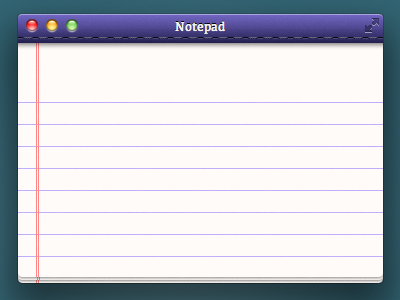创建类似于iTunes的窗口
来源:互联网 发布:脸萌不显示软件 编辑:程序博客网 时间:2024/04/28 02:43
INAppStoreWindow
Title bar and traffic light customization for NSWindow
INAppStoreWindow is an NSWindow subclass that was originally developed to mimic the appearance of the main window in the Mac App Store application introduced in OS X 10.6.6.
The MAS application has since transitioned away from this design, but INAppStoreWindow is still being actively developed to provide extensive additional customization options for NSWindow title bars.

Features of INAppStoreWindow:
- No private API usage and Mac App Store friendly.
- Fully customizable title bar view -- add subviews (toolbars, buttons, etc.) and block based drawing for custom backgrounds
- Adjustable title bar height
- Customization of the traffic light/fullscreen buttons for all button states.
- Customization of the window title text.
- Works on OS X versions 10.6-10.9
- Compatible with full screen mode in OS X 10.7+
All of these great apps are using INAppStoreWindow in production!
Usage
ARC
INAppStoreWindow now requires ARC to compile. If your project does not use ARC, compile INAppStoreWindow.m with the -fobjc-arc linker flag.
Basic Configuration
Using INAppStoreWindow is as easy as changing the class of the NSWindow in Interface Builder, or simply by creating an instance of INAppStoreWindow in code (if you're doing it programmatically). I've included a sample project demonstrating how to use INAppStoreWindow.
NOTE: The title bar height is set to the standard window title height by default. You must set the 'titleBarHeight' property in order to increase the height of the title bar.
Some people seem to be having an issue where the title bar height property is not set properly when calling the method on an NSWindow without typecasting it to the INAppStoreWindow class. If you are experiencing this issue, do something like this (using a window controller, for example):
INAppStoreWindow *aWindow = (INAppStoreWindow*)[windowController window];aWindow.titleBarHeight = 60.0;Adding buttons and other controls to the title bar
Adding controls and other views to the title bar is simple. This can be done either programmatically or through Interface Builder. Here are examples of both methods:
Programmatically
// This code places a 100x100 button in the center of the title bar viewNSView *titleBarView = self.window.titleBarView;NSSize buttonSize = NSMakeSize(100.f, 100.f);NSRect buttonFrame = NSMakeRect(NSMidX(titleBarView.bounds) - (buttonSize.width / 2.f), NSMidY(titleBarView.bounds) - (buttonSize.height / 2.f), buttonSize.width, buttonSize.height);NSButton *button = [[NSButton alloc] initWithFrame:buttonFrame];[button setTitle:@"A Button"];[titleBarView addSubview:button];Interface Builder
NOTE: Even though the content layout for the title bar can be done in Interface Builder, you still need to use the below code to display the view created in IB in the title bar.
// self.titleView is a an IBOutlet to an NSView that has been configured in IB with everything you want in the title barself.titleView.frame = self.window.titleBarView.bounds;self.titleView.autoresizingMask = NSViewWidthSizable | NSViewHeightSizable;[self.window.titleBarView addSubview:self.titleView];Centering the traffic light and full screen buttons
The vertical centering of the traffic light and full screen buttons can be controlled through two properties: centerTrafficLightButtons and centerFullScreenButton.
The traffic light buttons are vertically centered by default.
Hiding the title bar in fullscreen
You can tell INAppStoreWindow to hide when entering fullscreen mode, and reappear on exit. Just set the property hideTitleBarInFullScreenin order to hide it.
Padding the traffic lights and fullscreen buttons
The left padding of the traffic lights can be adjusted with trafficLightButtonsLeftMargin and the right padding of the fullscreen button can be adjusted with fullScreenButtonRightMargin.
Hiding the baseline (divider line between the titlebar and the content view)
The baseline divider can be hidden by setting showsBaselineSeparator to NO, the default value is YES.
Customizing traffic lights buttons
In order to customize these buttons, you would use INWindowButton class. You must create a separate instance for each button and provide your graphics for each state of the button. Currently the following states are supported:
- Active
- Active in not main window
- Inactive (disabled)
- Rollover
- Pressed
Please refer to INWindowButton.h header documentation for more details.
Customizing window's title appearance
You can enable title drawing by setting showsTitle property to YES. For NSDocument based apps, you can enable drawing the document proxy icon by setting showsDocumentProxyIcon property to YES. You can adjust appearance using titleTextColor, inactiveTitleTextColor, titleTextShadow, and inactiveTitleTextShadow properties. Also, you can enable title drawing in fullscreen by setting showsTitleInFullscreen property to YES.
Using your own drawing code
A lot of time and effort has gone into making the custom titlebar in INAppStoreWindow function just right, it would be a shame to have to re-implement all this work just to draw your own custom title bar. So INAppStoreWindow has a titleBarDrawingBlock property that can be set to a block containing your own drawing code!

[self.window setTitleBarDrawingBlock:^(BOOL drawsAsMainWindow, CGRect drawingRect, CGPathRef clippingPath){ // Custom drawing code! }];This block gets passed some useful parameters like if the window is the main one(drawsAsMainWindow), the drawing rect of the title bar(drawingRect), and a pre-made clipping path with rounded corners at the top(clippingPath).
Setting the title bar colors
If you just want to adjust the color of the title bar without drawing the whole thing yourself, there are a few properties to help you do so:
self.window.titleBarStartColor = [NSColor colorWithCalibratedWhite: 0.6 alpha: 1.0];self.window.titleBarEndColor = [NSColor colorWithCalibratedWhite: 0.9 alpha: 1.0];self.window.baselineSeparatorColor = [NSColor colorWithCalibratedWhite: 0.2 alpha: 1.0];self.window.inactiveTitleBarEndColor = [NSColor colorWithCalibratedWhite: 0.95 alpha: 1.0];self.window.inactiveTitleBarStartColor = [NSColor colorWithCalibratedWhite: 0.8 alpha: 1.0];self.window.inactiveBaselineSeparatorColor = [NSColor colorWithCalibratedWhite: 0.4 alpha: 1.0];Extensions
Additional extensions for INAppStoreWindow are provided in the Extensions folder.
NSDocument+INAppStoreWindowFixes
Add this category to your project to fix title bar layout for document based apps in response to -[NSDocument updateChangeCount:]. This fix was separated from the main INAppStoreWindow codebase because it swizzles methods on NSDocument.
INTitlebarView+CoreUIRendering
Add this category to your project to use CoreUI to render the system default title bar gradient, noise texture, and baseline separator. This will provide the most accurate visual results. You should only add this category to your project if you intend to release outside the App Store!
If you use this category you must define the preprocessor symbol INAPPSTOREWINDOW_NO_COREUI with a value of 1 in the build configuration for your Mac App Store version in order to exclude this code because ituses private APIs and will result in rejection if included in a Mac App Store submission.
When CoreUI rendering is not available, INAppStoreWindow will emulate the rendering of the system title bar as closely as possible.
- 创建类似于iTunes的窗口
- 创建类似于输入法窗口的非激活窗口
- 创建类似于输入法窗口的非激活窗口--续
- 创建类似于输入法窗口的非激活窗口
- 创建类似于输入法窗口的非激活窗口
- 生成类似于弹出窗口的页面
- iTunes Connect创建新的应用笔记
- 创建类似于 user(库)的文件夹
- JS窗口层滑动排序【类似于QQ空间的布局】
- 创建不使用信用卡的 iTunes App Store 帐户
- APP 上线 -在 iTunes Connect创建你的 App
- 如何创建QuickAction在Android对话 类似于苹果的效果
- [电脑技巧]如何创建类似于“我的文档”一样的系统文件夹:
- 怎么自己创建一个类似于smart的模版引擎
- 简单的窗口创建
- MFC 窗口的创建
- 浮动窗口的创建。
- 框架窗口的创建
- JAVA好难啊
- hdu3665 水最短路
- 小工具DeTexturepacker
- java Singleton 几种方式解析
- 树状数组的应用(SOJ2497)
- 创建类似于iTunes的窗口
- hdu1074之状态压缩dp
- C++中RTTI机制剖析
- NYOJ 104 最大和(求最大子矩阵)
- c语言奢侈单的游戏胆码
- hdu 2181 哈密顿绕行世界问题 (水dfs =。=)
- itoa与sprintf
- Oc 基础知识。
- jsp单击按钮没反应


